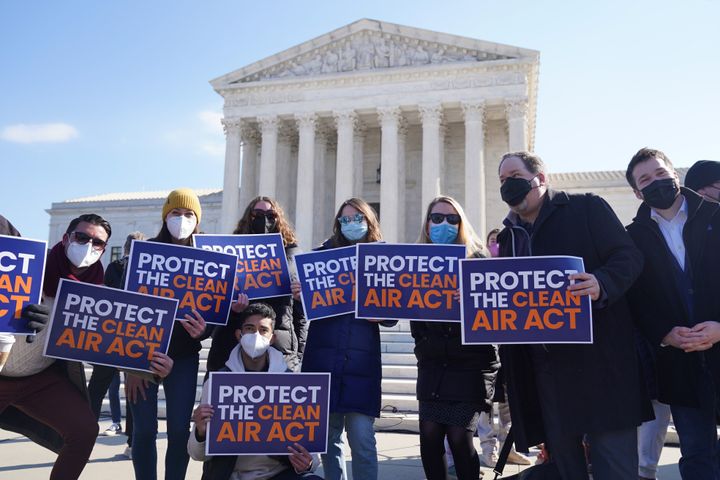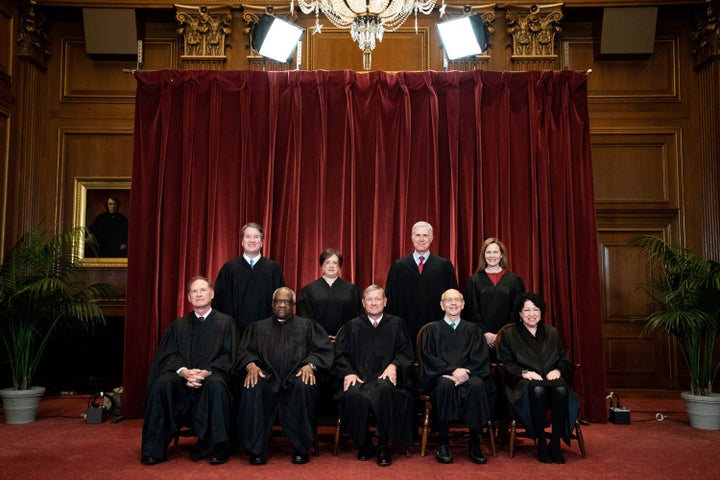On the same day a United Nations report found that the impacts of climate change will be even worse than we previously thought, the Supreme Court heard arguments that could significantly tie the hands of the Biden administration from doing anything about it.
The case before the court was brought by West Virginia and 20 Republican-run states and a group of coal companies seeking to prevent the Environmental Protection Agency from instituting new rules to limit power plant carbon emissions under the Clean Air Act. On the other side is the EPA, joined by a group of states and major power plant companies, who say the agency should have the power to write new carbon emission regulations.
The court took up this case even though the rules in question are entirely hypothetical. Nothing has even been written or proposed yet. The EPA argued that the court should dismiss the case and the petitioners should challenge the Biden administration’s rules after they are written.
The underlying issue in the case is whether the Clean Air Act allows the EPA to issue regulations that govern individual power plant sites themselves, such as adopting new technologies to reduce on-site pollution — known as “inside the fence” — or if the EPA can issue industrywide (“outside the fence”) regulations that would move high-emitting power plants to lower-emission energy sources.

A large part of Monday’s arguments revolved around whether the court needed to use something called the major questions doctrine to strike down the yet-to-be-proposed emissions rules. This doctrine purportedly states that agencies may not adopt regulations of “vast economic and political significance” without direct delegation to do so by Congress. Over the past decade, the court’s conservatives have developed the major questions doctrine into a tool to limit the federal administrative state, even though it lacks grounding in the actual history of Congress and its relationship with rule-writing agencies.
If it is deployed here to strike down a rule that hasn’t even been written yet, it would represent an escalation of the conservative court’s hostility to executive branch regulation and threaten to upend the judicial process of regulatory review.
The court’s six-member conservative bloc appeared skeptical of EPA arguments in defense of allowing the administration to write carbon emission rules and repeatedly questioned lawyers on both sides on whether the major questions doctrine could, or should, be used in this case.
West Virginia Solicitor General Lindsay See argued that regulations that determine “what the power sector on the whole should look like,” constituted a “new” and “transformative power” that raised major questions doctrine concerns. While U.S. Solicitor General Elizabeth Prelogar argued that the major questions doctrine should not only not be raised for a regulation that hasn’t even been written yet, but also because the court’s past precedents identified carbon emissions as pollution the EPA could regulate under the Clean Air Act.
Chief Justice John Roberts noted while questioning Prelogar that “there’s some disagreement about how to apply” the doctrine. Roberts wanted to know why the court shouldn’t first examine the import of the regulation “at the outset” to determine if it is “kind of surprising” that the agency is taking this regulatory action before looking at the actual impact of the regulation itself. As examples, Roberts raised cases where the court struck down the attempted regulation of tobacco by the Food and Drug Administration in the 1990s and the recent eviction moratorium imposed by the Centers for Disease Control and Prevention during the COVID-19 pandemic.

The problem with this, Prelogar argued, is that in every previous case the court actually had a regulation to question along with any examination of the issue “at the outset,” but here, the court is hearing arguments in a case where there are no new regulations to judge the costs or size of impact.
The West Virginia v. EPA case emerges from the ashes of the Obama administration’s Clean Power Plan, a 2015 regulation issued by the EPA to limit power plant carbon emissions. Those regulations were shelved after a 2016 Supreme Court ruling put a temporary halt to them and the Trump administration then repealed and replaced them in 2019 with regulations far more favorable to coal companies. Trump’s American Clean Energy rule was short-lived, as the D.C. Circuit Court of Appeals struck it down in January 2021. The group of GOP-run states and coal companies appealed this decision to the Supreme Court around the same time that the Biden administration declared that Obama’s Clean Power Plan was no more, so it would write new carbon emission regulations.
The petitioners from West Virginia and the coal companies argue that Obama’s Clean Power Plan was restored when the appeals court struck down Trump’s American Clean Energy rule. The court can then strike down Obama’s regulations to tie the hands of Biden’s EPA in writing new carbon regulations, they argue. But the Biden administration has stated that the Clean Power Plan was not resurrected by the appeals court and, Prelogar said, it would likely take between one and two years to propose and implement new regulations.
The absence of actual regulations for the court to judge may not matter to the court’s conservative bloc, as they have indicated an increased opposition to government regulation since expanding to six members after the death of Ruth Bader Ginsburg and her replacement by Justice Amy Coney Barrett in 2020.
Justice Samuel Alito suggested during arguments that EPA regulation of carbon emissions looked more like an effort to “regulate industrial policy” rather than pollution emissions as allowed under the Clean Air Act. He further noted that if you “if you take the arguments about climate change seriously,” that “this is a matter of survival,” then there should be no reason to believe that the “EPA can’t go even a lot further than it did in the [Clean Power Plan].”
Prelogar responded to Alito that there are limits in the Clean Air Act to what regulations the EPA can impose on power generation. But his statements underscored the increasing hostility to regulation from the court’s conservatives.
While West Virginia and the coal companies claimed that they did not believe they needed the major questions doctrine to win, the conservatives have recently relied on it to strike down major regulations like the Occupational Safety and Health Administration’s vaccine-or-test rule and the CDC’s eviction moratorium.
With West Virginia Democratic Sen. Joe Manchin’s failure to support Biden’s climate agenda blocking any legislative action, a ruling striking down executive branch regulations aimed at mitigating carbon emissions would further speed up the catastrophic timeline envisioned in Monday’s IPCC report.

